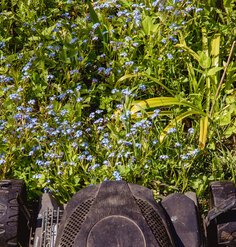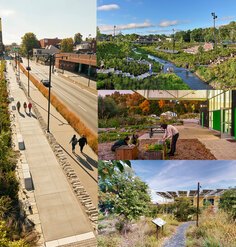From the Field: Reaching Across Disciplines to Understand a Landscape's Performance and Impact
By Sarah Hanson, MLA Candidate, Illinois Institute of Technology
Landscape architecture bridges gaps between numerous disciplines. It brings together design, science and ecology, engineering, and social sciences to develop living spaces meant for human and animal habitation. This year through LAF’s Case Study Investigation (CSI) program, our Illinois Institute of Technology (IIT) team collaborated with a wide range of professionals to understand the environmental, economic and social impacts of Palmisano Park in Chicago, Illinois.
Situated in the historically industrial neighborhood of Bridgeport on Chicago’s south side, Palmisano Park, or Stearns Quarry, as it’s informally called, was once a limestone quarry and then a landfill. Today, it is a park that over 90% of survey respondents classified as “unique” among Chicago parks due to its native prairie and wetland planting, over a 33-foot hill (a rare thing in Chicago!) and an exposed quarry wall, which lines the edge of a fishing pond.
As a student of design with a background in sculpture, the technical aspects of landscape architecture and landscape performance initially seemed foreign but were nonetheless intriguing. Participating in the CSI research, especially through the Palmisano Park study, I have had the opportunity to reach out to professionals in unfamiliar fields. The development of these partnerships has allowed what were once distant concepts to become familiar to me, all the while providing insight into the performance of the site.
Working with the Urban Wildlife Institute at the Lincoln Park Zoo, we installed a camera to monitor wildlife throughout Palmisano Park. While limited images were captured, starting a discussion with this group lead to a new partnership which raised UWI’s awareness of this native-planted park as well as our awareness of their ongoing urban wildlife research. We hope that Palmisano can become a long-term addition to UWI’s study of wildlife patterns within the city, as anecdotal sightings of fox, coyote, owls, and cranes have been noted on several occasions. Additionally, my future design studies can utilize UWI’s research.
Through conversations with and training from engineers, we performed water quality testing on-site, an activity with which the research team had little prior experience. WESTON Solutions, the project engineer, offered initial consultation on ways to test the wetland treatment cells’ water quality, something neither modeled nor conducted during site design and construction. Following up with an IIT Armour College of Engineering professor and student, we received lab training and assistance in testing for dissolved oxygen and TSS (total suspended solids). Learning new methods provided an opportunity to dig deeper into performance-based thinking to understand how landscape design effects these environmental systems.
Attending an advisory council meeting for the park and visiting the site frequently revealed a wealth of information about the site’s history, its impact on residents’ daily life, and its educational component. The Palmisano Park Advisory Council President, Maureen Sullivan, also the founder of the Bridgeport Business Association, has been an important advocate for the park since its opening. She has helped to organize stewardship days, including the annual spring Clean and Green Day, in which over 100 volunteers participate. As a lifelong resident of the community and co-author of the book, Bridgeport(Images of America), she provided an oral history of the neighborhood and the park’s recent importance within it by turning unusable space into a place of community gathering.
Conducting on-site surveys during a musical performance for Chicago Park District’s “Night Out in the Park” sparked conversations that praised the park for giving the neighborhood a place for all community members to enjoy. In addition to forming professional partnerships, a relationship was formed between Palmisano and the adjacent McGuane Park, which features athletic fields, a playground, and an indoor recreation center. This collaboration was furthered this summer through the construction of a children’s learning garden highlighting native plants of Palmisano, and the development of a booklet for self-guided plant identification tours of the park.
It is gratifying and rewarding not only to forge our own partnerships as a result of CSI but to know that the park has been the catalyst for many community-based activities and new neighborhood relationships. The case study research has recorded environmental, economic, and social benefits that carry on with or without acknowledgment, but which further our understanding of the landscape’s performance.
Research Fellow Mary Pat Mattson and student Research Assistant Sarah Hanson are participating in LAF’s 2014 Case Study Investigation (CSI) program. They are working to evaluate and document the performance of three exemplary landscape projects in the Chicago area. Any opinions expressed in this article belong solely to the author. Their inclusion in this article does not reflect endorsement by LAF.











